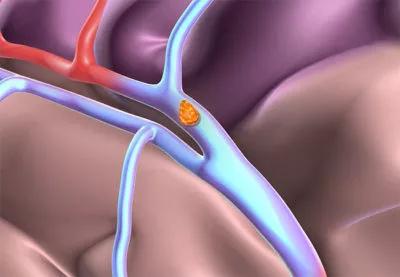$2M NIH grant will help see if dual-action agent lengthens treatment window

Cleveland Clinic researchers have received a five-year, $2 million grant from the National Institute of Neurological Disorders and Stroke to investigate a novel stroke therapy that uses tissue plasminogen activator (tPA) conjugated to nanoparticles. The research will assess the ability of a novel dual-action agent combining tPA with antioxidant-loaded nanoparticles to dissolve blot clots and protect the brain from reperfusion injury following stroke.
Advertisement
Cleveland Clinic is a non-profit academic medical center. Advertising on our site helps support our mission. We do not endorse non-Cleveland Clinic products or services. Policy
The grant was awarded to Vinod Labhasetwar, PhD, Professor and Endowed Chair in Nanomedicine, Department of Biomedical Engineering, Cleveland Clinic Lerner Research Institute, who is collaborating on the project with M. Shazam Hussain, MD, Director of Cleveland Clinic’s Cerebrovascular Center.
tPA is the only FDA-approved medical therapy for dissolving arterial clots to reestablish blood flow to the brain after ischemic stroke. While tPA is effective, it carries a risk of potentially fatal hemorrhage, especially if given more than four and a half hours after stroke. Because of this narrow window for treatment, only a small fraction of ischemic stroke patients receive tPA treatment, which profoundly limits its clinical use.
Moreover, tPA can cause worsening of reperfusion injury, which occurs when blood flow is rapidly restored to tissues devoid of blood and oxygen during a stroke. Reperfusion injury is mediated by excessive production of reactive oxygen species (ROS), highly damaging molecules produced by cells under stress.
Dr. Labhasetwar has sought to counteract the effects of ROS with antioxidant enzymes. To that end, he and his team developed a new tPA nanoconjugate in which antioxidant enzymes are encapsulated in nanoparticles (synthesized using FDA-approved material) that are then attached to tPA. Nanoparticles are engineered to improve drug delivery, particularly for agents susceptible to rapid degradation in the body.
In earlier experiments, administration of tPA, followed by nanoparticles loaded with the antioxidant enzymes, was shown to be more effective than administration of tPA alone; in a model study, it was beneficial even when administered six hours after a stroke.
Advertisement
In their new study, the investigators will test tPA nanoconjugate, a new dual-action therapeutic agent that can both dissolve the clot and protect the brain — and can potentially be given beyond the time window typically used for tPA alone. The researchers will evaluate how this tPA nanoconjugate affects neurological and vascular recovery and function and how it protects against reperfusion injury, all while maintaining the positive thrombolytic effects of tPA.
The ultimate goal is to develop the tPA nanoconjugate as a safe and effective stroke treatment that will reduce patient disability. Anticipating additional and larger clinical studies in the near future, the team hopes to find the optimal dose of the tPA nanoconjugate to offset the effects of ROS and help stroke patients recover as much neurological and motor function as possible.
“A treatment like this would be effective and safer, and could be given over a longer period of time, which would help more stroke patients,” says Dr. Labhasetwar. “We also could use this tPA nanoconjugate to treat blockages in other organs, such as the heart, and prevent reperfusion injury caused by excess ROS in those organs. This would open up many new treatment possibilities.”
“This is important research,” adds Dr. Hussain. “While tPA is effective for stroke, it has limitations, especially for large clots, and carries a significant risk of hemorrhage. Nanomedicine offers the opportunity to create a more effective and safer thrombolytic, which could increase the number of patients who are able to receive this lifesaving and disability-reducing treatment.”
Advertisement
Advertisement

First full characterization of kidney microbiome unlocks potential to prevent kidney stones

Researchers identify potential path to retaining chemo sensitivity

Large-scale joint study links elevated TMAO blood levels and chronic kidney disease risk over time

Investigators are developing a deep learning model to predict health outcomes in ICUs.

Preclinical work promises large-scale data with minimal bias to inform development of clinical tests

Cleveland Clinic researchers pursue answers on basic science and clinical fronts

Study suggests sex-specific pathways show potential for sex-specific therapeutic approaches

Cleveland Clinic launches Quantum Innovation Catalyzer Program to help start-up companies access advanced research technology